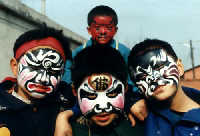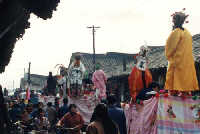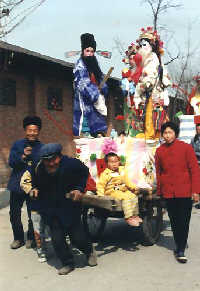 Practiced during Spring Festival in theChinese lunar calendar, Shehuo is a spontaneous traditional festive occasion for songs and dances prevailing mainly in the countryside of North China. With a long history, these festive affairs are rooted from the primitive sacrificial activities in which ancient people prayed for harvest and affluence with their songs and dances from "She", originally meaning the God of Earth, and "Huo", literally meaning fire which ancient people believed to have the magic power of driving away the evil spirit.
Practiced during Spring Festival in theChinese lunar calendar, Shehuo is a spontaneous traditional festive occasion for songs and dances prevailing mainly in the countryside of North China. With a long history, these festive affairs are rooted from the primitive sacrificial activities in which ancient people prayed for harvest and affluence with their songs and dances from "She", originally meaning the God of Earth, and "Huo", literally meaning fire which ancient people believed to have the magic power of driving away the evil spirit.
Scattered historical records demonstrate the existences of Shehuo in theSpring and Autumn Period(770- 476BC), the Warring States Period(475-221BC) and Song Dynasty (960-1279). By the time of the late Qing Dynasty(1644-1911), Shehuo in some places had been incorporated with theTemple Fairs.
476BC), the Warring States Period(475-221BC) and Song Dynasty (960-1279). By the time of the late Qing Dynasty(1644-1911), Shehuo in some places had been incorporated with theTemple Fairs.
But the reasons why Shehuo has survived and developed throughout Chinese history is not only limited to the sacrificial purpose. Shehuo is also a mass entertainment activity that involves a great deal of performers, virtually enabling almost all the men in the village to participate either in the performance or the preparation work. Besides, it is also the natural outpouring of enthusiasm and love for life as well as a demonstration of talents and vitality.
performance or the preparation work. Besides, it is also the natural outpouring of enthusiasm and love for life as well as a demonstration of talents and vitality.
In every first month of the Chinese lunar calendar, the neighboring villages will all send their representatives to take part in the region's celebration, making the slack season in farming also the year's most jubilant and joyful period.
There are many kinds of performances in the Shehuo activity. The main kinds include Xinzi (standing on wick), carrying desks, stilts, bamboo horse, lion dance and the land boat. Among them Xinzi and stilts are the most popular.
Xinzi is more like acrobatics. Little girls and boys in the traditional costumes may stand on the edge of a "sword", "flower", "tree branch", or even "corn leaves". Some even use "spears" stabbing into the abdomen of the performer. In the ancient time, four, eight or even a dozen of people would lift up the desks that carry the children. On some desks there are two to four stories with a plate rotating in the center.
Author: Jeff
